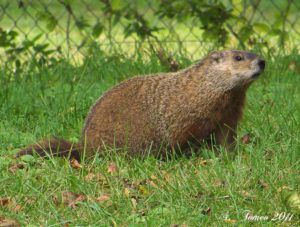All About Pests: Everything You Need to Know About Woodchucks
Understanding Woodchuck Behavior and How to Protect Your Property

Woodchucks, commonly known as groundhogs, are large rodents that can wreak havoc on your yard and garden. These burrowing animals are not only a nuisance to homeowners due to the damage they cause to vegetation, but their burrows can also compromise the stability of structures such as sheds or decks. Let’s examine everything you need to know about woodchucks - their habits, diet, and, most importantly, how to keep them from domain your property.
Woodchuck Habits
Woodchucks are solitary creatures and are most active during the day, particularly in the early morning and late afternoon. They are known for their digging habits and will create extensive burrows with multiple entrances. These burrows can extend up to 30 feet long and damage lawns and foundations if built too close to buildings.
During the warmer months, woodchucks spend their days foraging for food and digging, but as fall approaches, they prepare for hibernation by significantly increasing their food intake. In winter, woodchucks hibernate in their burrows, which helps them survive colder temperatures.
Diet
Woodchucks are primarily herbivores and have a varied diet. They feed on grasses, clover, alfalfa, and dandelions, but they are also known to raid vegetable gardens, feasting on crops such as carrots, lettuce, beans, and peas. Additionally, they may eat fruits like berries and apples.
Although plant-based foods comprise the bulk of their diet, woodchucks are opportunistic feeders and may occasionally eat insects or other small animals.
How to Keep Woodchucks Away from Your Property
Woodchucks can cause significant damage to your lawn, garden, and even your home's foundation. Fortunately, there are several effective methods to deter them from taking over your yard.
- Fencing
Installing a sturdy fence around the perimeter is one of the most effective ways to keep woodchucks out of your garden. However, because woodchucks are excellent dodgers, your fence must be designed to prevent them from burrowing underneath. Here’s how:
- Use a fence that is at least 3 feet high.
- Bury the fence 12 inches below the ground.
- Angle the bottom of the fence outward to make it harder for woodchucks to dig underneath.
Additionally, the top of the fences should be floppy or curved to prevent woodchucks from climbing over it.
2. Remove Attractants
Woodchucks are attracted to areas with an abundance of food and cover. To make your yard less inviting to them:
- Harvest your garden regularly to remove tempting food sources.
- Remove piles of brush, wood, or debris that woodchucks could use as cover.
- Keep the grass short to make it less attractive to them as a grazing area.
3. Use Repellents
Several natural repellents are available that can help keep woodchucks away. Critter Repellent’s
Shake-Away Woodchuck Repellent uses natural predator scents to create an environment that woodchucks will want to avoid. Simply apply the granules around your garden or yard to deter them from entering.
Another option is to use homemade repellents, such as a mixture of water and hot pepper spray. This can be applied to plants or areas where woodchucks are active, making these areas less appealing.
4. Trapping
Trapping may sometimes be necessary to remove a persistent woodchuck from your property. Live traps can be baited with fruits or vegetables to lure the woodchuck in. Once trapped, contact your local wildlife authorities to relocate the animal.
5. Hire a Professional
If woodchuck activity is causing extensive damage or you cannot keep them at bay with DIY methods, it might be time to call a professional wildlife removal service. They can assess the extent of the problem and use safe, practical strategies to remove the woodchucks and prevent them from returning.
Woodchucks can be a severe pest for homeowners, causing damage to lawns, gardens, and structures. By understanding their habits and diet, you can take preventative measures to keep them away from your property. Whether it’s through fencing, repellents, or professional help, multiple strategies are available to protect your yard from these burrowing creatures.
Critter Repellent All Natural Animal Repellent Blog












